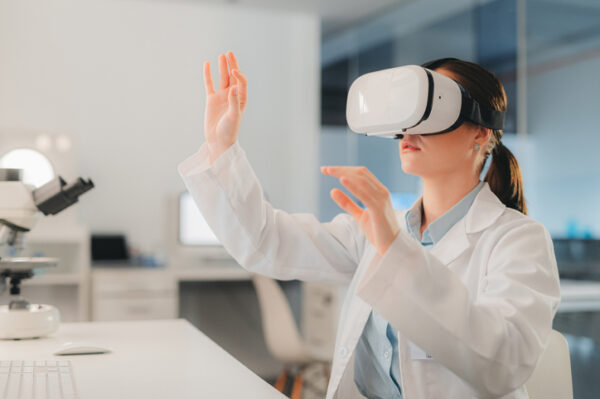Verve Therapeutics now has the formal FDA documentation specifying what the regulator wants to see before it allows the company to begin human testing of its gene-editing therapy for an inherited form of high cholesterol.
VERVE-101 is designed to turn off PCSK9, a gene that produces a liver protein that makes it more difficult for the body to clear low-density lipoprotein, the “bad” form of cholesterol. Patients have already been dosed in a clinical program underway in New Zealand and the U.K. Last month, the FDA placed a clinical hold on the Boston-based company’s new drug application for a U.S. trial.
The FDA wants to see more preclinical data regarding potency differences between human and non-human cells as well as additional data about the risks that the changes made by the therapy can be inherited by a patient’s children, Verve said in a Monday regulatory filing. The FDA asked that Verve modify the clinical trial protocol in the U.S. to incorporate additional contraceptive measures and to increase the length of time between the dosing of patients.
The FDA also has concerns about off-target effects. The filing states the agency asked the company to provide analyses of data showing whether the therapy’s effects reach cell types beyond liver cells. Furthermore, the FDA has asked to see the available data from New Zealand and U.K. so far. Those data were not part of the initial submission filed with the FDA. Verve said enrollment is continuing in those regions and the company plans to report initial safety and pharmacodynamic data from the dose-escalation part of the trial in the second half of 2023. Without specifying a timeline, the company said it plans to submit a response to the FDA’s information requests “as expeditiously as possible.”
The lifting of a clinical hold on another experimental genetic medicine was among the other recent regulatory news from the past week, which included two drug approvals and one rejection. Here’s a roundup of those developments:
—The FDA lifted a clinical hold on the investigational new drug application for a Beam Therapeutics gene-edited cell therapy for acute lymphoblastic leukemia. The FDA placed the hold on the program, BEAM-201, in August. With the hold lifted, the Cambridge, Massachusetts-based biotech is now cleared to proceed with tests in humans. BEAM-201 is an off-the-shelf cell therapy that employs four edits made with base-editing technology. Beam said it will provide details for the program’s next steps in 2023.
—The FDA has approved the first fecal microbiota treatment for preventing the recurrence of Clostridioides difficile (C. diff) infection in adults. The regulatory decision covers those who have finished a course of antibiotics for the potentially deadly infection. The Ferring Pharmaceuticals product, named Rebyota, is made from stool provided by qualified donors. This rectally administered live biotherapeutic is intended to restore the gut microbiome, which in turn prevents episodes of C. diff infection.
—A Rigel Pharmaceuticals drug won FDA approval for treating acute myeloid leukemia (AML) with a particular genetic signature. The South San Francisco-based biotech will commercialize the drug, olutasidenib, under the name Rezlidhia. The small molecule is designed to target mutated isocitrate dehydrogenase-1 (IDH1), an enzyme found in cancerous cells. Blocking this enzyme is intended to restore normal differentiation of myeloid cells. The regulatory decision for Rezlidhia covers the treatment of adults whose AML has the IDH1 mutation as detected by an FDA-approved test.
—The FDA turned down Y-mAbs Therapeutics application seeking approval for its drug to treat a rare pediatric brain cancer. The drug, omburtamab, was developed to address leptomeningeal metastases, which is the spread of neuroblastoma from the brain to the membranes surrounding the brain and spinal cord. The negative regulatory decision came a little more than a month after an independent advisory committee to the FDA voted unanimously that New York-based Y-mAbs had not provided enough evidence to show that the clinical program, which compared omburtamab to a historical control group, improved overall survival in patients.
—Eli Lilly’s Covid-19 drug bebtelovimab is no longer authorized for use anywhere in the U.S. According to the FDA, the change was made because the antibody is not expected to work against the omicron subvariants BQ.1 and BQ.1.1., which together account for 57% of all cases nationally. Revocation of the Lilly drug’s emergency use authorization removes from the market the last remaining monoclonal antibody drug for Covid-19.
Photo: Sarah Silbiger, Getty Images
I don’t think anyone can really be prepared for their first time using a virtual reality headset. Technology has become such a familiarized part of our lives that I think its brilliance can sometimes be lost on us, but virtual reality has given people a taste of something they’ve never experienced before. Virtual reality isn’t a technology that simply complements our lives, it’s a technology that brings our lives into an entirely new reality.
It’s no wonder that virtual reality’s impact has been far-reaching. You can be transported to any corner of the world and feel like you’re really there. You can purchase movie tickets and watch a film in a VR cinema with your friends. And of course, you can play a huge variety of video games that make you feel like you’re part of the action.
So, what does this have to do with healthcare? While virtual reality applications don’t seem like they’d have much use in the healthcare industry, VR has proven to be a valuable tool in treatment and care. Medical teams have used virtual reality to plan out and practice complex surgeries, like a neurosurgical procedure, ahead of time. It’s been used as a pain management tactic to distract patients from scary or painful procedures, especially in instances where sedation and anesthesia can’t be given. It’s also helped professionals working in addiction recovery be more creative in the strategies and techniques they use to help their patients overcome their addictions. But another remarkable way virtual reality is applied in the healthcare industry is as a training tool.
Thanks to VR, facilities are able to create simulations for a number of different scenarios that employees can experience from a first-person perspective. Here’s how this is revolutionizing healthcare training.
A deeply immersive and interactive education
Medical professionals know that healthcare is a high-stakes industry, so they’re thankful for all the stages of training they go through to adequately prepare themselves for their future roles. Extensive classroom training, training in the field, and being mentored by seasoned medical professionals is all significant, but being on your own for the first time can be intimidating.
Virtual reality gives new doctors, nurses, and medical staff the ability to immerse themselves in real-life scenarios as if they were in charge. They can see the immediate consequences of their actions and can learn from their correct or incorrect behaviors. They can be exposed to dangerous or life-threatening situations and practice resolving each scenario without putting themselves or their patients in any real danger.
Facilities are always researching and developing new ways to enhance their training processes, and what better way to do that than to have new staff members immerse themselves in situations they could experience while on the job? This is how facilities can enforce self-awareness in their employees while creating more confident, capable teams. Studies have shown that experiential learning also drives higher compassion for patients as well. This is much harder to accomplish with more traditional training methods where employees can’t get regular, hands-on practice.
Virtual reality-based training has been proven to improve performance across the healthcare industry while reducing the possibility of fatal errors. Nothing prepares someone for the real thing more effectively than a program built to replicate real-world experiences.
New or updated equipment training
In order to continue providing the best care to patients, medical equipment must constantly be updated or replaced with new devices. With any new feature, there’s always a learning curve — except in healthcare, these learning curves can have dire consequences.
Training new employees on new or updated equipment can be extremely time-consuming, and facilitating times to introduce staff members to the equipment can be a headache. Virtual reality not only makes equipment training faster and more accessible, it also gives everyone an opportunity to practice using the equipment, tools, and technology as much as they need to in order to feel more comfortable before using it for the first time.
Higher staff retention
Since the beginning of the pandemic, the healthcare industry has seen an increase in staff turnover across hospitals, skilled nursing facilities, and other medical offices. As executives find ways to entice their employees to stay, it seems like some of the common incentives, like higher pay and bonuses, are no longer good enough to combat record levels of burnout and fatigue.
In addition to their wellbeing, doctors, nurses, and other medical staff are also choosing to leave their jobs due to a lack of personal growth and poor self-confidence — both of which put patients at a greater risk of danger. Facilities must invest in the ongoing education and training of their teams, which will help staff members develop greater confidence and competence. Virtual reality exceeds the traditional training methods facilities often use, and this new immersive, experiential way to train staff members is critical for their proficiency and satisfaction. VR simulators have been shown to boost procedural confidence and develop technical on-the-job skills. Investing in your employees means investing in advanced technology that will allow them to perform better in their roles.
Virtual reality helps to build confident, collaborative teams that then create a positive workplace environment for other staff members and patients alike. Using tools like virtual reality to train the current and next generations of healthcare workers is another way executives can commit to enhancing the industry as a whole.
Photo: Moyo Studio, Getty Images


